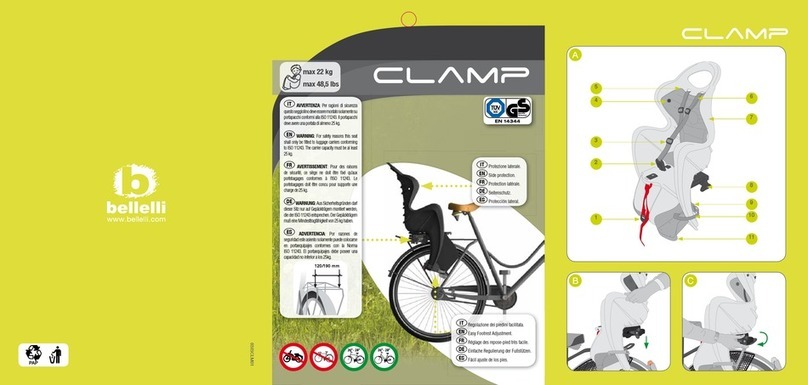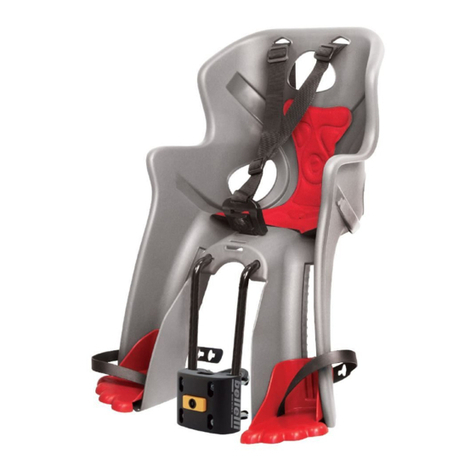
10
B-FIX RELAX -IT
Congratulazioni e grazie per aver acquistato il nuovo seggiolino bici. Se desiderate informazioni su
altri prodotti Bellelli, consultate la nostra pagina web www.bellelli.com.
Le presenti istruzioni valgono esclusivamente per i seggiolini posteriori Bellelli.
Prima del montaggio e dell’uso, leggere attentamente le rispettive istruzioni. Non montare il
seggiolino seguendo semplicemente le illustrazioni in copertina.
Conservare le istruzioni per un’eventuale consultazione futura.
AVVERTENZE
ATTENZIONE: Il seggiolino è stato progettato esclusivamente per il trasporto di un bambino. Non
appesantire il seggiolino con ulteriori carichi. Gli eventuali carichi da trasportare devono essere
posizionati sulla parte anteriore della bicicletta, utilizzando altri supporti, ad esempio un portapacchi
anteriore.
ATTENZIONE: E’ proibita qualunque modica al seggiolino ed ai suoi supporti. Il produttore o il
commerciante declinano ogni responsabilità per eventuali danni derivanti da modiche.
ATTENZIONE: La manovrabilità della bicicletta può essere inuenzata in modo signicativo dalla
presenza di un bimbo sul seggiolino, soprattutto per quanto riguarda l’equilibrio, la sterzata e la
frenata.
ATTENZIONE: Non lasciare mai la bicicletta incustodita con un bambino sul seggiolino.
ATTENZIONE: Non utilizzare mai il seggiolino nel caso una qualunque delle sue componenti e/o di
quelle della bicicletta siano difettose o mancanti. Contattare il produttore o rivenditore per procurarsi
eventuali pezzi di ricambio. A seguito di incidenti, sostituire il seggiolino in ogni sua parte, sebbene
non mostri danni evidenti.
INFORMAZIONI GENERALI SUL MONTAGGIO
Il seggiolino posteriore per bambini va montato dietro al guidatore.
Installare il seggiolino nella direzione di marcia.
Il ssaggio si adatta a telai a sezione rotonda nonché ad una varietà di telai a sezione ovale.
Leggere attentamente il paragrafo “Montaggio del supporto”.
Il seggiolino è dotato di un sistema di montaggio tramite forcella di supporto e slitta, inserita alla base
del seggiolino per regolarne l’inclinazione.
Utilizzare il seggiolino per biciclette 26 “- 28”, che supportano carichi supplementari da almeno 27 kg
(59,5 lb). Consultare il manuale della bicicletta o il proprio rivenditore di ducia.
Allacciare sempre la cintura di sicurezza al bambino e le cinghie dei poggiapiedi. Vericare
accuratamente che il bambino sia adeguatamente assicurato al seggiolino. Leggere attentamente il
paragrafo “Mettere a sedere il bambino sul seggiolino”.
Montare il seggiolino inclinandolo all’indietro. Inclinarlo leggermente verso il retro, per trattenere
meglio il bambino.
Dopo il montaggio del seggiolino, controllare periodicamente la bicicletta, prestando particolare
attenzione ai pneumatici, ai freni e ai fanali.
INFORMAZIONI GENERALI SULL’UTILIZZO
Prima di utilizzare il prodotto, informarsi sul codice stradale del paese in cui verrà utilizzato.
IT IT

































